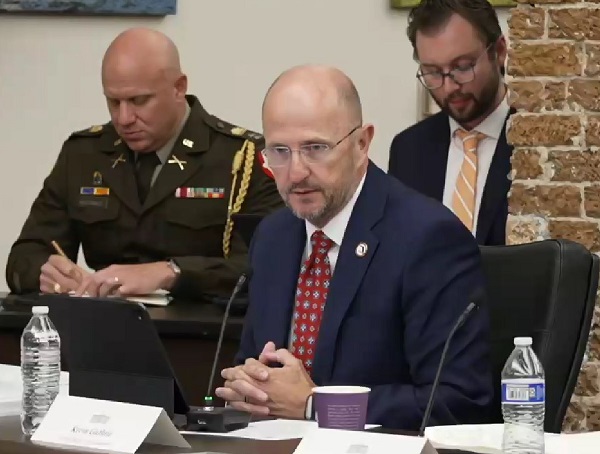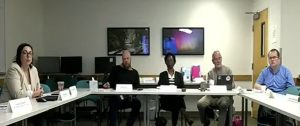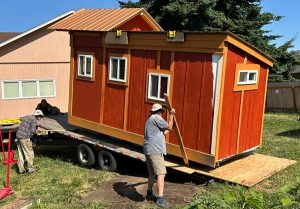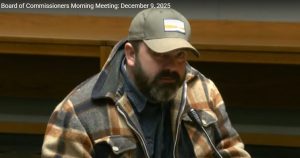Local officials echo FEMA Review Council in emergency management meetings July 9
10 min read
Presenter: The second meeting of the FEMA Review Council convened July 9 without one of its key members: Nim Kidd was supporting his state’s response to flooding in West Central Texas. Homeland Security Secretary Kristi Noem:
Kristi Noem (Homeland Security, secretary): You know, when President Trump first established this review council, the goal was very simple. It was to provide recommendations on how to streamline and to right-size the federal government, especially in its role in disaster management.
[00:00:27] Now, I was in Texas this weekend and was there dealing and working with the individuals who are experiencing this heartbreaking tragedy, and saw firsthand the devastated families, the reeling community, the leaders that are there on the ground responding.
[00:00:44] We certainly supported that immediately on search and recover efforts and partnered with the state and local governments to get Americans all of the resources that they need.
[00:00:53] Working together, state officials like Nim Kidd and the governor and his team, along with all the other agencies involved, have coordinated efforts that have rescued over 850 people. We now currently have an ongoing flooding situation going on in New Mexico as well, which we are in communication with the governor on and continuing to work there.
[00:01:14] And what President Trump has empowered us to do is to let these states and local emergency management officials run and make decisions that best respond to their communities. And we be a support that comes in and comes alongside them when they need us.
[00:01:29] Federal emergency management should be state- and locally-led, rather than how it has operated for decades. It has been slow to respond at the federal level. It’s even been slower to get the resources to Americans in crisis. And that is why this entire agency needs to be eliminated as it exists today and remade into a responsive agency. We owe it to all the American people to deliver the most efficient and the most effective disaster response.
[00:01:56] In fact, some of how we’ve responded to Texas is exactly how President Trump imagined that this agency would operate, immediately making decisions, getting them resources and dollars that they need so that they can conduct the response that they need to do on the ground.
[00:02:12] This job of remaking this agency is not nearly as simple as it should be, because we’re up against decades of gross mismanagement and negligence. The list of FEMA’s failures is staggering. The scale of those failures is matched only by their longevity. FEMA has been disastrous at times, incompetent at times, and not just in the last few years but for decades. There’s times FEMA has performed very well and has responded and delivered the help that people needed.
[00:02:46] Presenter: And there’s times FEMA has not done quite as well. At a wildfire situation report the same day, July 9, Rep. Val Hoyle:
[00:02:54] Rep. Val Hoyle: And I will tell you: Even previous to the Trump administration, we are still waiting on reimbursement from some of our 2020 fires. And that is accurate. So our federal system does need to be fixed.
I am working with some Republicans, specifically (Sen.) Tim Sheehy from Montana, who’s a Republican senator who has, you know, he was a private contractor that did firefighting and he understands what’s needed and we are working together to try and see what practical application we can have to make sure that we get out in front of these fires.
[00:03:32] Presenter: At the FEMA Review Council, Secretary Noem:
[00:03:35] Kristi Noem (Homeland Security, secretary): The answer is going to be putting the federal government in its proper place, getting this bloated bureaucracy out of the way. And so that is why President Trump created this FEMA Review Council. The responsibility that you have is incredibly important.
[00:03:51] The future of disaster management has to be led by local communities and by states, with the federal government coming in in a supporting role, empowering them, not hindering them and slowing them down with paperwork, bureaucracy, and lack of resources.
[00:04:06] State and local leaders know that their communities, they know what they need better than the government ever could. They know their exact needs and they know how best to prepare.
[00:04:16] People forget that the states are older than the Constitution and that they created the Constitution, that federalism matters and states’ rights need to be respected. We need to focus more on helping, not hindering, and state and local authorities need to be empowered. We don’t take charge of them. We give them the opportunity to lead the way.
[00:04:37] Now, a leader is someone who empowers others to do their job well and to be the best that they can be. The job of government is not to do everything for the people. It’s to let people do things for themselves and empower them to make decisions and take personal responsibility for their lives, but to help them when a crisis happens.
[00:04:55] Presenter: Defense Secretary Pete Hegseth:
[00:04:58] Pete Hegseth (Department of Defense, secretary): I’ve seen the images and gotten the reports of the Texas National Guard in Texas, of the Coast Guard Search and Rescue. We’re monitoring it closely. Where there is disaster, where there is need, the Defense Department is poised and ready to be a part of that.
[00:05:13] This time last month, DoD assembled a whole of government team in San Antonio to exercise and analyze response strategies for the 2025 hurricane season. And I’ve also approved annual actions that ensure Gen. (Gregory M.) Guillot, who’s the commander of USNORTHCOM, is able to rapidly surge support during the greatest hour of need.
[00:05:34] What we know at DoD is in times of crisis, there are certain capabilities, certain things that DoD, whether it’s National Guard on the federal side, can do that other state-and-locals just not. And so we look forward to being a part of that team that helps review what FEMA does and how it does it. And we look forward to everyone’s feedback and participating in these discussions.
[00:05:59] Presenter: Vice chair of the FEMA Review Council, former Mississippi Gov. Phil Bryant:
[00:06:05] Phil Bryant (FEMA Review Council, vice chair): We’ll turn now to the executive order which has given the authority to the council to create subcommittees.
[00:06:13] Council has created three subcommittees. Subcommittee first of the subcommittee of federal state coordination is co-chaired by Gov. Glenn Youngkin and Gov. Greg Abbott.
[00:06:24] Of course, the Texas prayers go out and thoughts again to Gov. Abbott and his team. These two co-chairs are charged with the evaluation in the traditional roles of the federal/state government in disaster management.
[00:06:39] Its primary task is to examine the role of the state and their coordination with the federal government in securing life, liberty, and property of their citizens.
[00:06:49] Second subcommittee is a subcommittee on disaster response recovery assessment. It is co-chaired by Kevin Guthrie, executive director of the Florida Division of Emergency Management, and Nim Kidd, the chief of Texas Division of Emergency Management.
[00:07:08] Again, we can only imagine what Nim has been going through since the Fourth of July, when we were all looking forward to being with our families and our barbecues. Very early in the morning of July 5, as I recall, Nim and his team began work with that tragedy and have not stopped.
[00:07:28] And finally, the final report subcommittee, which I co-chair in cooperation with Michael Watley, who is also co-chair of the final report committee, which responsibility will be to draft the final comprehensive report that we’ll be—we’ll present the council’s conclusions and recommendations to the President of the United States in request of his executive order 24 January.
[00:07:57] Presenter: With the first committee, Gov. Glenn Youngkin:
[00:08:01] Glenn Youngkin (Virginia, governor): What we have completed over the course of the last few weeks since our last meeting is a substantial step in beginning to understand, first, the roles of states, local and federal government as they stand today, and beginning to map what they should be as we go forward.
[00:08:22] We have also been reviewing 12,000 public comments. We’ve also been preparing a spider chart so that we can understand the full nature of the federal government’s involvement.
[00:08:35] And then finally, we are beginning the mapping exercise of what exists today. This is incredibly important. What are the roles of the localities? What are the roles of states, and what are the roles of the various federal government authorities, and particularly FEMA?
[00:08:51] Those roles, in fact, spread across preparedness, mitigation, response, and recovery. There are 32 different core FEMA capabilities that need to be understood, each one of those core capabilities has a varying role that currently either has localities or states playing the primary lead or FEMA. And as you have heard us discuss, we have seen time and time again, that the localities and states are well prepared to respond to many of these emergencies.
[00:09:30] Gov. Abbott and the team in Texas are doing extraordinary work. This tremendous, tremendous display of a natural disaster’s force, a flood that’s elevated 20 to 25 feet in 45 minutes, that caught sleeping children and many others at four o’clock in the morning by surprise. This moment is one that has brought us all to our knees. We’ve asked the Lord to comfort, to receive. We’ve asked him to provide the resources to find every last victim. May God have mercy on their souls. Thank you.
[00:10:17] Presenter: With the second committee, the top emergency management official in Florida, Kevin Guthrie:
[00:10:23] Kevin Guthrie (Florida Division of Emergency Management, executive director): Something that is starting to emerge, and I shouldn’t say starting to, I think we as a practitioners group knew that this was always the case.
EMAC, Emergency Management Assistance Compact, continues to be our number one go-to thing. I think what’s starting to evolve from that, and we’ve heard this from numerous directors and governors. I’m sure the governors have heard this as well.
[00:10:46] You see evidence by Texas, you see evidence by New Mexico and other disasters that we’ve had around the country this year: Governors will send their staff. And I will tell you, as a director working directly for Gov. Ron DeSantis, he never asks me the question, ‘Are we going to get reimbursed?’ He always does the right thing. He sends the people out the door. We’ll figure out the reimbursement later.
[00:11:12] But at the end of the day, governors will be much more apt to send their individuals out the door if they know they are going to get reimbursed. And how can we improve that? And we think we have some ways that we will be recommending to the acting administrator as well as potentially 44 CFR revisions to help get that done so that governors know that when they do send help they’re not ultimately going to be given a bill and that come out of local taxpayer dollars versus coming from the federal government.
[00:11:44] Presenter: With the third committee, chair of the Republican National Committee, Michael Watley:
[00:11:49] Michael Watley (Republican National Committee, chair): There’s a couple of thoughts that continue to kind of percolate, I think. The first is that a lot of the ideas that we see, when we’re talking about what FEMA does, we’re talking about how FEMA does it, and the rest of a government response, because again, the federal government response is not limited to FEMA. It makes sense in a vacuum, but as we’ve seen just this week, we don’t live in a vacuum, right?
[00:12:14] And so as we’re thinking through what is this response going to be, what is federal emergency management need to look like, you know, we’re going to continue to be responding in real time to these storms.
[00:12:28] And secondly, I want to thank President Trump for his vision here because I think that as we have seen over the course of emergency management back to the 60s, every time we see a major event that takes place, there’s an immediate reaction to it. Sometimes it is just put in place by the president through executive fiat. Sometimes there’s legislation that looks at it, but it’s very reactive.
[00:12:54] And what president has tasked us with doing here is being proactive and making sure that we are setting up a program that may be FEMA, it may be a different entity, and that we have a lot of other actors within the federal government that are going to be involved.
[00:13:11] But more importantly, what are the states going to be doing? And what are the local governments going to be doing? That we have a proactive discussion as we’re moving forward is going to be extremely important for us, you know, and so I feel like the president’s vision here is something that is going to last far beyond his term.
[00:13:31] Presenter: The second meeting of the FEMA Review Council occurs just days after the tragic flooding in Texas. The council hears that many federal partners—including the military—have roles in an emergency. Meeting the same day, July 9, Lane County officials were also speaking about emergency management. Commissioner Pat Farr:
[00:13:52] Commissioner Pat Farr: In the case of an event, a large event that spans the lighthouse to the volcanoes, we do rely on the sheriff immensely, both by design and by default to cover us in an emergency.
[00:14:05] So just to understand that as we look to funding the sheriff’s department, we’re not just funding patrol. We’re not just funding corrections. We’re funding this all-important function of the sheriff’s department.
[00:14:16] Presenter: The county’s emergency manager sounded a similar theme of mutual aid and local self-reliance. Tiffany Brown:
[00:14:23] Tiffany Brown (Lane County, emergency manager): Red Cross in the county isn’t here to give you a shelter. We’re here to provide you with the resources and the subject matter expertise to help yourselves in a bad day. Not because we don’t want to help, but because we understand that helping yourselves on that very bad day is actually the most effective way to take care of a community. So that’s exciting work.
[00:14:45] Presenter: In local meetings July 9 that echoed the FEMA Review Council, Rep. Val Hoyle says she too is working to reform the agency. And just as the secretary of defense mentioned the military as a key federal partner, Commissioner Pat Farr emphasized the essential role of the Sheriff’s Office in emergency response.
[00:15:05] The council’s recommendations are due Nov. 16.






